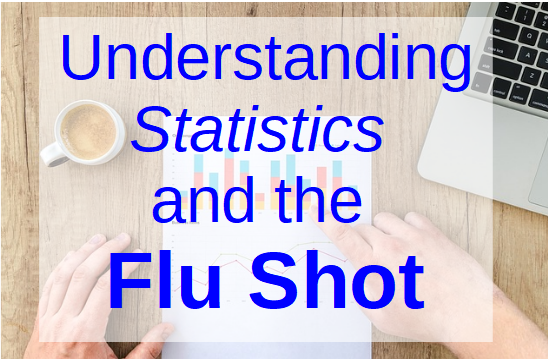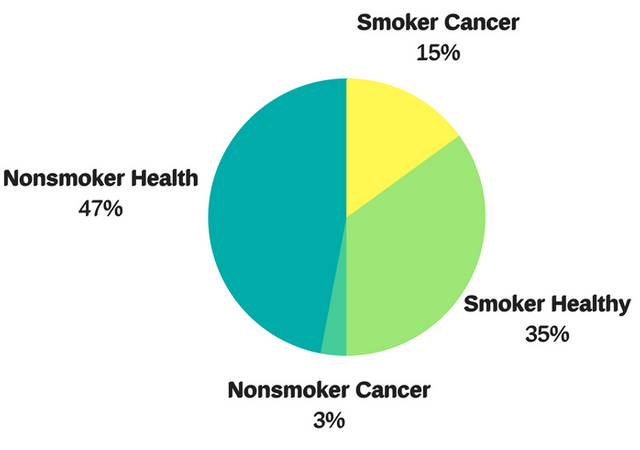Understanding Attributable Risk vs Relative Risk vs Absolute Risk with the Flu Shot.
I was recently researching for a cold and flu talk and decided to include what the real numbers say for how effective the flu shot is and wanted to share some of those results with the Steemit community while teaching about the different way studies report benefit. So I present you with ...

First for the math part so you can understand where my calculations come from. Note I do not consider myself a math expert by any means so if I do something funky in my calculations please let me know.
Attributable Risk
Attributable risk, in non-technical terms, is the difference in rate of a event happening in a population compared to second population with a different variable.
Attributable risk = Incidence of event - Incidence of placebo.
Attributable risk is expressed as a percentage relative to the incidence rate in the (exposed) population, not the whole population. This calculation can be deceiving if there is a large population that only has a small subset affected by a condition.
Say you have a group of 100 people and half of them smoke. Out of the 50 smokers say 15 get cancer and out of the 50 nonsmokers 3 get cancer.

The attributable risk percentage would be equal the rate of smoking cancers(15/50 =0.3) - the rate of placebo cancers (3/50 = 0.06) divided by the rate of smoker cancers (0.3)
So in a neater equation that looks like:
AR= (0.3-0.06)/0.3 x100%
= 0.8 x 100%
= 80% So smokers in my fictitious example have a 80% greater rate of getting cancer then non-smokers.

Relative Risk
Relative risk is how you compare the risk of an event between two groups. While not assuming that everyone is at risk of getting the event. It is given as a rate and always compares two groups.
RR = (a/a+b)/(c/c+d) Relative risk explaination.
= (15/(15+35)) / (3/(3+47)
= (15/50) / (3/50)
= 0.3 / 0.06
= 5 So there is 5 times the risk of cancer for a smoker relative to the nonsmoker in the above group.
You can take relative risk and subtract 1 from it to get the percent effect so (5-1x100% = 4) a smoker is 400% more likely to get cancer the a nonsmoker (100% starting risk)
*Note a lot of sources will say relative risk when they really mean attributable risk.

Absolute Risk
The absolute risk is the actual percentage of the outcome in the whole population. So in the above example the absolute risk of getting cancer is 18% (18/100) for the entire population. The absolute risk of a smoker to get cancer is is 30% (15/150) since then you are only looking at the smoking population.
Notice how that is a much smaller number then the attributable risk? Yet the absolute risk is the average risk for a individual.
The problem with pharmaceutical marketing is that most people are told the attributable risk without being given the absolute risk for the condition. Would you take a medication if it was statistically only going to prevent a significant outcome in 1 in 100 people while having a 30% chance of giving you a minor side effect?
So now that I had that teaching moment lets get to the nitty-gritty details of the CDC flu shot statistics that I found.

Flu Shot Stats
Last year the CDC reported the effectiveness of the flushot as 42%. This is calculation is based off of a odds ratio which is approximately equal to relative risk. Said another way 58% of the people tested who got the flu were immunized with the flu shot.
To find the average absolute risk reduction of the flu shot first you need to know the absolute risk of the flu. The CDC estimates that there are between 9.2 - 35.6 million cases of the flu a year in the USA.
To calculate the absolute risk we need to know the total US population. We will be generous and use the 2010 data of 302 million people.

So the absolute risk of getting the flu would be 9.2 to 35.6 / 302 x100% = 3.0 to 11.8 % risk of getting the flu at the beginning of the flu season for the average American.
With last years flu shot being 42% effective the absolute risk that it decreases your chance of getting the flu at the beginning of the flu season is only between 1.3% - 5.0% reduced risk (3 x 0.42 x100% = 1.3%). Since you are not guaranteed to come in contact with the flu.
With all the negative hype around flu shots is a 1.3-5% reduced personal risk really worth it?

Please let me know in the comments below. Also please let me know if my final calculation was inappropriate based on the source data. (Been a while since I took stats.)
Maybe the flu shot is worth it if you don't have anything else to treat it and are worried about it being potentially fatal?
However my next post will discuss a study using a natural health product that fairly effectively treats the flu and reduces its symptoms at least every bit as good if not better the the flu shot.
Till next time,

References
Vaccine Effectiveness Rates
CDC Influenza Incidence
Risk Ratio Explaination
Pictures originally sourced from Pixabay.com
Graph generated on Canva.com
Wikipedia links in text
I used to memorized them before my exam. Those are always difficult for me to understand and keep in mind.
Which is why so many people don't really understand the how small the real benefit of many medication or even supplements are.
Relative risk percentages can be so misleading. Thanks for putting it in perspective.
Congratulations that good content, I love reading quality in publications and that you provide a truthful and autonomous information
Thanks, I don't write too often but when I do, I hope that it is good.
One of the goals for my blog is to show that there actually is good evidence for plenty of what I do as a naturopathic doctor.
@healthbasics your calculations seem to be worthly and appropriate!!
And majorily people who are suffering from flu are caused by cold whether and if you dont take proper medication, it becomes more effective! Majorly people waits and say its a little flu it will gone by time but that does not happens all the time!
The flu survives much longer in colder air. It is still possible to get the flu in the summer just less likely.
My next post will go into a couple of things to take for reducing the symptoms of the flu that isn't Tamiflu (Oseltamivir generic name) medication.
I think what you mean is that attributable risk is expressed as a percentage relative to the incidence rate in the (exposed) population.
Thanks I like that wording better myself.
please upvote my writings bung
thank you
Risk is risk when nothing is in mind disc
https://steemit.com/@rkkk
best decided
I support your decided